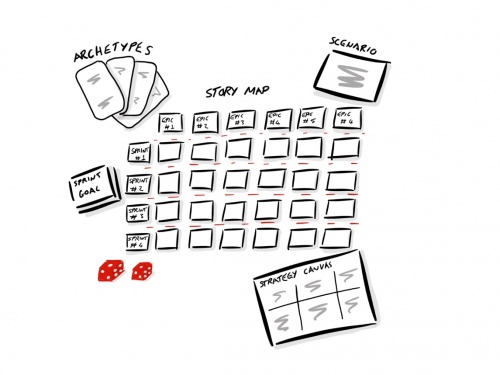Backlog Strategy
Jump to navigation
Jump to search
Outcomes
This exercise provides an opportunity to increase your awareness of the challenges and dynamics present in a product or project, and how you can implement a strategy to aid the successful delivery.
The exercise provides several scenarios and accompanying product backlogs with items that are used to create a story map, which is then enhanced and arranged with respect to defined archetypes in order to provide a better outcome. The latter part of the workshop finishes with a brief simulation to test the new approaches and a debrief to reflect on the observations of the exercise.
Timings
- Allow 90 mins for this exercise.
Equipment
- user story templates
- header templates
- sprint goal templates
- archetypes templates
- strategy canvasses
- scissors
- post-it notes
- sharpies or similar
- 5 x dice per team
- flip chart paper and markers
Tasks Part 1: Setting Up The Story Map
- As a team choose which scenario you would like to tackle
- Read the scenario and the user stories to get familiar with them
- Arrange the user stories, and header templates to form a story map and release plan over several sprints, (check out the diagram of the story map.)
Tasks Part 2: Thinking Holistically
- Work through the Strategy Canvas to identify:
- Your observations of the story map
- Where you think the value in the work is?
- Where are the challenges and risks in the work?
- Are there any dynamics that you can identify that give rise to the challenges and risks?
- Which of the archetypes do you think are appropriate for the scenario and the corresponding Product Backlog?
- How do you think you might implement those archetypes in the Product Backlog?
- Adjust your story map and release plan to implement your chosen archetypes recomposing the content of the sprints to get the best possible outcome
Tasks Part 3: The Simulation
- Throw the dice to simulate a team’s velocity for 1 sprint i.e. 5 x dice = 5 days effort = 1 sprint velocity
- Mark off those items that were completed in the story map for that sprint
- Refine and adjust the story map to reconfigure the release plan with respect to the archetype and items that were not completed in the sprint.
- Repeat throwing the dice and adjusting for the next 5 sprints
Tasks Part 4: The Debrief
- Finally on a sheet of flip chart paper write down what you observed from the exercise and share back with the other teams



